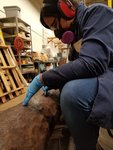By Guy Busby, guy@gulfcoastmedia.com
SPANISH FORT – A large iron cannon excavated in Spanish Fort will soon go on display at City Hall, Mayor Mike McMillan said.
City officials know that the gun was found during an excavation in the city in 2017. What no one knows for sure, however, is how the massive artillery piece got to its location, who made it or how old it might be, according to officials. One local history expert called the piece, “a fascinating mystery.”
Jessica Burns with the Florida Bureau of Archaeological Resources has been working to preserve the gun since it was found. She said the cannon is old, but no one can say how old or where it was manufactured.
“The surface is corroded to the point that there are no markings visible that might indicate its age or where it was made,” she said. “I wouldn’t be able to speculate on any of that.”
The gun is 8.75 feet long, according to bureau reports. It has a muzzle diameter of 3.75 inches and is 41 inches in circumference at the base. The report listed the age of the cannon as undetermined.
McMillan said one person present when the gun was found speculated that it might have been brought to the site by the Spanish in the 16th century.
Mike Bunn, director of Historic Blakeley State Park, said he has not seen the gun, but was told the approximate site where it was found. The location has not been officially released to protect the site from anyone attempting to dig up other artifacts, city officials said.
Bunn said Spanish Fort has been the site of several battles and forts during the Civil War and American Revolution. The community’s name comes from a fort built by the Spanish who captured the area from the British during the American Revolution.
“The Spanish Fort area has a long and colorful colonial-era history involving French, British, and Spanish occupations before the region came into American hands,” Bunn said. “All maintained some type of military fortifications in the Mobile Bay area, and there was fighting between Spanish and British on the Eastern Shore during the American Revolution.”
Bunn wrote a recent book on the history of the Mobile Bay region during the 18th century when the site was part of the British colony of West Florida from 1763 to 1780. He said no forts or other military installations were known to have been built near the site where the cannon was found.
“I haven’t had a chance to study the artillery piece in question, but at first glance it appears it could well be from the 18th century,” he said. “Based on where it was recovered, it would seem there is at least circumstantial evidence that it might have been brought here during British or Spanish occupations of the region during that time period, but as to where it came from, why it was brought here, and where it would have been placed, we have no definitive information. It’s a fascinating mystery.”
The Spanish Fort City Council voted in November to accept a $7,500 grant from the Alabama Historical Commission to build a site where the cannon can be displayed outside City Hall.
“It’s going to be a great addition to City Hall,” McMillan said. “It’s a great part of our history.”
He said that when the gun was found, city crews and community members helped remove the cannon. He said the gun was heavy enough that a vehicle tow truck was needed to lift the iron piece.
Crews wrapped the barrel in bandages to protect the metal surface once it had been removed from the ground.
“We had to wrap it in Ace bandages to keep the metal flakes from falling off,” McMillan said. “We must have spent $300 on Ace bandages.”
Burns said that once the gun was delivered to her bureau in Tallahassee, the artifact was treated through an electrolysis process for almost two years to remove corrosive salts and other elements that would cause the iron to deteriorate. When that process was completed, the gun was treated with several coats of protective coatings to protect the iron.
The barrel was also plugged to prevent water from getting inside the gun and causing more damage.


